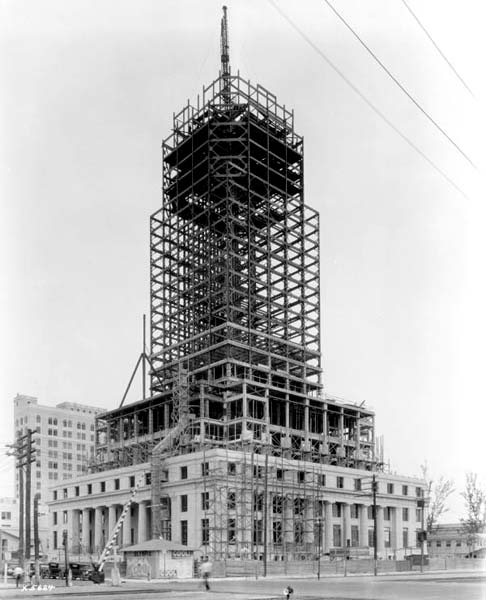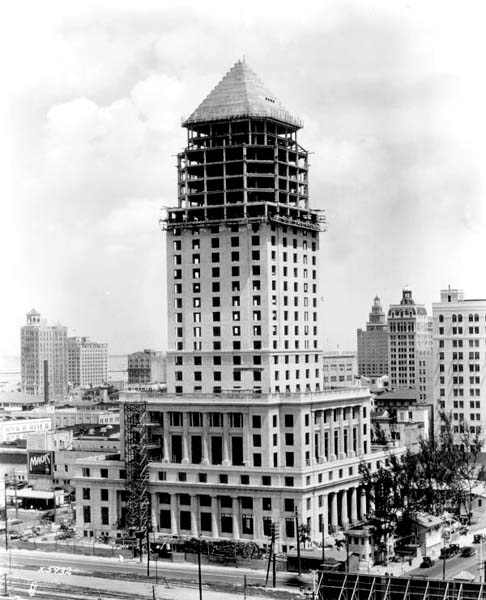Some pictures from the Dade County Court House, Miami. I've always wanted to know what was at the very top of this very historic building. It was the highest structure in the County for many years. I knew from history that it had been a major radio system site but all the antennas had been removed when the last major renovations had been done. All of the radio equipment had been moved to the County Administration Building, 31 floors high.
Since I was in the area i went in and asked if there was anything left of the old radio equipment. Some of the GSA team there knew exactly what I was talking about and gave me a great behind the scenes tour of the highest levels of the building. The VHF and UHF equipment had been removed, but there was still plenty of interesting stuff left.
Most of these are behind the scenes pictures that only someone into telecom would be interested in. The building is historic and has been beautifully restored. If you get a chance, take a look at the lobby and any of the public areas. If you like historic buildings, there's so much to see here. It's way more interesting than this pictures show.
Click on the thumbnails to see the image full size.
An abandoned GE Microwave system. It looks like it was from maybe the 1960s. Left in place because there is no elevator service to this floor. The waveguide seem to be 6 GHz.
Old Southern Bell Telco Demarc. Tags indicate these were RTNC, analog, radio circuits. Many existing and old Fire Department radio sites are mentioned on the tags. This appears to have been a major comparator site for the Fire Department.
There's a roof access opening, just large enough to climb out. But there's only a thin ledge to climb out to. And no rails or places to hang on to. I also took some blind shots from above me toward the peak. You can see white stains from where the famous turkey buzzards perch.
Here's an old box of 660 watt tower light bulbs. They plan to restore the light at the top when some safety equipment has been installed. While LED tower lights would be much more efficient, I would like to see the old fashioned look of an old incandescent red light slowly blinking.
More sings of old radio and telephone equipment on a higher floor.
Views up toward the water tanks. Still in use for domestic water. There's another smaller one for the fire hose cabinets but it's not in use any more.
Where an old A/C pump was located. The Court house was air-conditioned in 1957. Some original units are still in service.
The prisoner elevator room. Believe it or not, this original elevator is STILL in service. They use it a couple times a year. It's still totally manual operation. They keep it going for the sake of the history of the building. When I get some time I'll ask Otis about this serial number.
This is the 'main' telephone room for the building on the 7th floor. I'm guessing it was upgraded in the 1960s. There's an abandoned 48 VDC power system. Some of the batteries still have fluid in them.
This green device near the ceiling appears to be a huge selenium rectifier.
A actual battery that appears to be needed in a power supply of that era.
Other wall mounted equipment in the phone room.
Telephone cross connect wires from the black cable from the Grande Central Office. This is cross connected to the internal cables to other phone rooms. You can see the older protectors with wire wrap connections and even old style soldered connections on some blocks.
A very old florescent light fixture. The bulbs are actually up against the ceiling. Only the ballast is enclosed.
Yes, a FUSE box. They said many other fuses and cartridge fuses are still in use in the building.
The gray oval devices are repeat coils. There were mostly for local radio station feeds so they could provide live coverage of trials.
Some shots of the outside of the building.
![]()
More information about the Dade County Court House:
| Florida State Archives 1927 - Dade County
Courthouse under construction in downtown Miami (Available from Don
Boyd's web site here:
http://www.pbase.com/donboyd/image/77199878):
|
Florida State Archives 1927 - Dade County
Courthouse under construction in downtown Miami (Available from Don
Boyd's web site here:
http://www.pbase.com/donboyd/image/77199643):
|
![]()
A history of the building from the Clerk of Courts: http://www.miami-dadeclerk.com/dadecoc/Dade_County_Courthouse.asp
Dade County Courthouse
Miami-Dade County Courthouse
73 W Flagler Street | Miami, Florida 33130
Telephone: (305) 275-1155 | Business Hours: 9:00am- 4:00 pm
When county government was established following the Civil War, public records were so sparse they could be carried in a carpetbag and most probably were. Therefore, the "courthouse" was wherever the county's chief office holder decided to do business.
In 1890, Miami-Dade County's first courthouse stood in the town of Juno, Florida some ten miles north of West Palm Beach. At that time, Miami-Dade County covered more territory than it does today, stretching from Bahia Hondo, in the middle Keys up to the St. Lucie River north of Palm Beach.
Juno was chosen as the "county seat" because of its strategic location at the southern terminus of the Jupiter-Juno railroad, as well as, the northern terminus of the boat and connecting stagecoach line to Miami. The courthouse remained in Juno (now no longer in existence), until 1899 when it was moved to Miami "down the inland waterway on a barge and was placed on the banks of the Miami River, east of the old Miami Avenue bridge.
The building was a two story wooden frame construction, housing offices and jail cells on the ground floor and a courtroom on the second floor. In 1904, this building was replaced by a new courthouse building situated on Flagler Street (then known as "D" Street). It was a magnificent building constructed of coquina rock, having an elegant red-domed top. All this at the outrageous cost of $47,000! It was anticipated that this courthouse would serve the city for at least fifty years, however, no one was prepared for the rapid growth Miami experienced during this period, and by 1924, only twenty years later, there was serious talk of the need for a larger courthouse.
City and County officials readily approved the plans drawn up by architect Antony Teneycke Brown. It was decided to build the new courthouse at the same location as the existing one on Flagler Street. Construction began in 1925, with workers erecting the new building around the existing structure, which was then dismantled. Community leaders and citizens alike voiced excitement over the new 28 story "skyscraper" that would soon dominate the skyline.
Unexpectedly, construction was halted when the building reached ten stories. It was discovered that the "high-rise" was sinking into the spongy ground. Engineers consulted with an architect from Mexico City who had encountered a similar problem while building the city's opera house. The consultant determined that the foundation pilings were not set deep enough. To correct the problem cement supports were poured which take up much of the space in the building's basement file room even to this day.
The courthouse was finally completed in 1928 at a cost of four million dollars. Initially, it served as both the Dade County Courthouse and the Miami City Hall. Jail cells occupied the top nine floors because these heights offered "maximum security" and were considered escape proof! In 1934 a prisoner housed on the twenty-first floor, picked the lock of his jail cell window and used a fire hose to lower himself to freedom. In the years following, more than 70 prisoners escaped from this so-called secure prison.
For many years the Dade County Courthouse, at an elevation of 360 feet, was reputed to be the tallest building south of Baltimore. It was the County's first high-rise and is in the National Register of Historic Places. Efforts to refurbish this magnificent structure and restore it to its original grandeur have been underway since 1981. Currently, the restoration of the lobby to its original distinction is the passion of engineer Don Youatt, of the Metro-Dade Planning and Development Department. With a little less than half of the funding necessary for the lobby restoration project in hand ($300,000 grant approved by the Legislature in 1996) the Dade County Bar Association will act as the fund-raising umbrella and initiate a drive to raise the remainder needed from lawyers and the general public.
Today, the Dade County Courthouse, provides offices, chambers and courtrooms for the clerks and judiciary assigned to the Circuit and County Civil Court and the Family Court. Its hopes to serve the county as a focal point for all of its governmental activity, soon were overpowered and unseated by a tremendous growth of population which continues to the present. The Courthouse, once the hope for a grand future, now simply stands as a memory of a grand and hopeful past.

